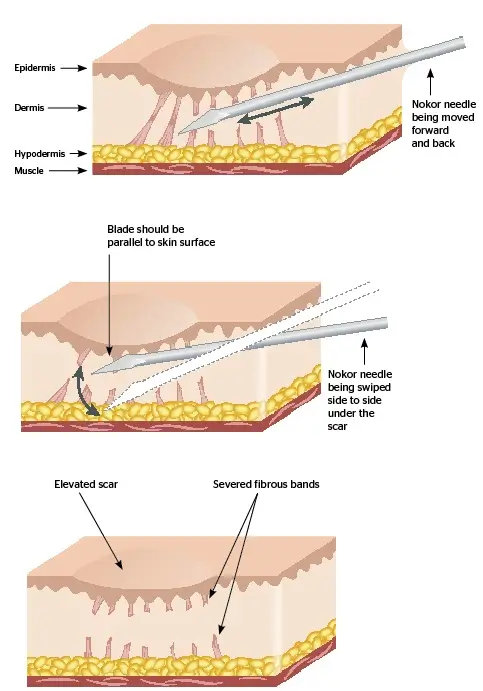
Understanding Skin Subcision: A Guide To Treatment And Recovery
Skin subcision is a minimally invasive surgical procedure designed primarily to treat atrophic scars, such as those caused by acne, and cellulite. The process involves the use of a special needle to break up fibrous bands beneath the skin that tether and pull it down, creating uneven surfaces.

How It Works:
Subcision aims to lift depressed or indented scars by releasing the fibrous strands that pin the skin down to deeper tissues. During the procedure, a dermatologist or cosmetic surgeon inserts a fine needle into the skin’s surface and gently moves it back and forth in a fanning motion under the scar. This action tears the fibrous threads and encourages new collagen production as the skin heals, raising the indented areas over time. The process typically takes around 30 minutes to an hour, depending on the size and number of treatment areas.
Who Is It Suitable For?
Skin subcision is primarily suitable for individuals with depressed scars, particularly rolling or boxcar acne scars. It can also address some cases of cellulite. It’s important for potential candidates to have realistic expectations and understand that while subcision can significantly improve scar appearance, it may not completely eliminate them. This treatment is generally less effective on keloid or hypertrophic scars, which protrude from the skin rather than being recessed.
Before proceeding with subcision, an evaluation with a qualified dermatologist or cosmetic surgeon is necessary to ensure there are no underlying conditions that might complicate the treatment, such as poor wound healing or infections.
Downtime and Recovery:
One of the benefits of skin subcision is its relatively short recovery time compared to more invasive techniques. Patients might experience bruising, swelling, or slight discomfort in the treated area, typically resolving within one to two weeks. Over-the-counter pain relief can help manage any discomfort.
Although the procedure is minimally invasive, aftercare is crucial to ensure optimal healing and results. Patients are usually advised to avoid excess sun exposure, vigorous physical activities, or harsh skincare products for a few days post-treatment.
Improvement in the skin’s appearance can be gradual as collagen continues to develop, usually becoming noticeable after a few weeks. For optimal results, subcision is often performed in conjunction with other treatments like laser therapy or fillers.
In conclusion, skin subcision is a promising option for those seeking enhanced skin texture and appearance without extensive downtime. As with any medical procedure, it is vital to consult with a qualified professional to evaluate suitability and tailor the approach to individual skincare needs.
How many sessions of subcision are typically needed?
The number of subcision sessions needed can vary based on the severity of the scars being treated and the individual’s skin response. Typically, patients might require anywhere from 1 to 3 sessions, spaced about 4 to 6 weeks apart. However, some individuals might need more sessions for optimal results, especially if the scarring is severe. It’s best to consult with a dermatologist or qualified healthcare provider to get a personalized treatment plan.
At-home care tips after subcision
1. Avoid Strenuous Activities: Refrain from intense exercise or activities that may cause sweating for at least 48 hours.
2. Ice Application: Apply ice packs to the treated area intermittently to reduce swelling and discomfort during the first 24-48 hours. Wrap the ice pack in a cloth to avoid direct contact with the skin.
3. Pain Management: Over-the-counter pain relief, such as acetaminophen, can help alleviate any discomfort. Avoid NSAIDs like ibuprofen, as they may increase bruising.
4. Gentle Cleansing: Cleanse the area gently with a mild cleanser and lukewarm water. Avoid scrubbing the skin.
5. Avoid Sun Exposure: Protect the treated area from direct sunlight. Use a broad-spectrum sunscreen with SPF 30 or higher if you have to be outdoors.
6. Moisturization: Keep the skin well-moisturized to aid healing. Opt for non-comedogenic, fragrance-free moisturizers.
7. Watch for Signs of Infection: Keep an eye on the treated area for signs of infection, such as excessive redness, increase in swelling, or pus. Contact your healthcare provider if these occur.
8. Skip Makeup: Avoid applying makeup to the treated area for at least a few days to minimize the risk of irritation and infection.
9. Follow-Up Visits: Attend any scheduled follow-up appointments with your dermatologist to monitor the healing process and discuss further treatments if necessary.
Why Choose Us?
At The Astell Clinic, we specialize in providing top-tier treatment products to help you achieve a youthful and refreshed appearance. Our experienced professionals are dedicated to personalized care and outstanding results.
Contact Us For Your Free Online Consultation Today.




